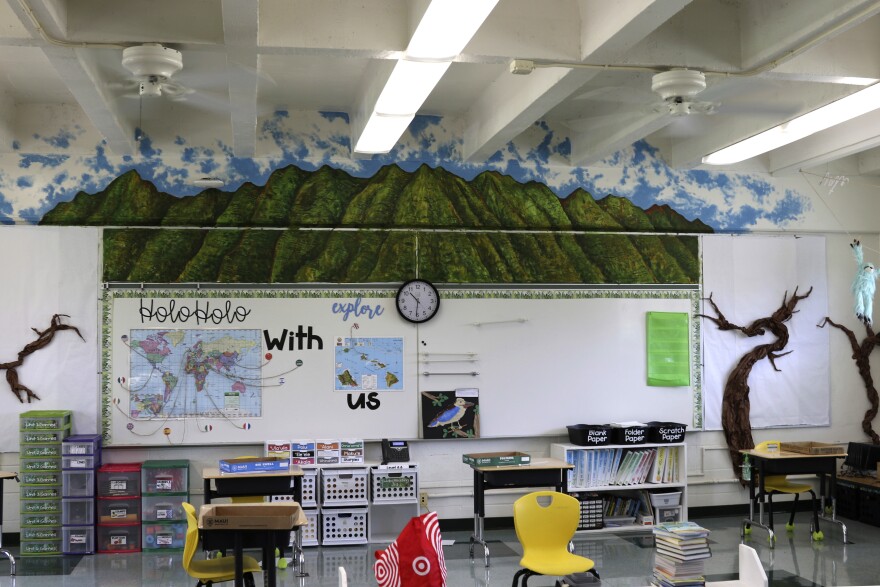A report from the Hawaiʻi Department of Education shows public schools have made progress despite the lingering impacts of the pandemic — but there's still room for improvement.
The department earlier this month released the results of its Strive HI Performance data for the 2021-22 school year. It measures student achievement through a series of metrics — including proficiency assessments, graduation rates, and chronic absenteeism. The goal is to measure student achievement beyond federal requirements and test scores.
Overall, the latest report shows year-over-year progress in language arts, math and science proficiency. Aptitude in English language arts rose two percentage points to 52%. Math proficiency increased by six points to 38%. Meanwhile, science competency saw a five-point boost to 40%.
Third-grade literacy, which has been increasing since 2015, rose four points to 80%.
"In the area of student achievement, it is a standardized test," DOE spokesperson Nanea Kalani said.
The DOE uses the Smarter Balanced Assessments, which is also used by other states to meet federal requirements. Students in grades three to eight, and high school take the test.
Other metrics, such as absenteeism, graduation rates and career and technical education program completion rates, are reported by the schools.
Kaunakakai Elementary School on Molokaʻi saw significant student progress last school year. Principal Daniel Espaniola tells HPR they experienced the same issues most schools faced last year, such as chronic absenteeism.
"Our absenteeism really skyrocketed. I believe it was 63% ... and two years ago, it was 13%," said Espaniola. "The pandemic was still in full force, and we were having a lot of (COVID) cases ... according to our DOE guidelines and policies, (students) would quarantine for 10 days."
A jump in students missing class time resulted in other challenges like learning loss, and a lack of meeting social and emotional needs.
Despite these challenges, Kaunakakai still managed to see students succeed academically. In a year, the school saw a 12% boost in English language arts, a 22% increase in math, and a 33% hike in science proficiencies.
Espaniola said the difference was the faculty and staff.
"There was so much communication between the parents and the teachers, because they needed to communicate more about what's happening," he said.
Espaniola said teachers and school staff helped families understand how platforms such as Google Classroom and Google Docs worked to ensure students were able to learn remotely. Teachers also recorded lessons to allow students to review missed classroom time.
Education assistants were able to identify students who were struggling and give comprehensive tutoring sessions after school.
"Our counseling and our positive behavior, intervention support team, was really working overtime to ensure that all the kids that needed social, emotional help was getting that — and their families," Espaniola said. "Teachers and faculty staff, they showed their love, their resilience and really caring for students by going above and beyond — and working after hours."
Espaniola said another challenge was digital equity and access. With the help of federal and state pandemic aid, in addition to the school's Title I funding, Kaunakakai was able to purchase devices for students to use at home and in the classroom. The school also provided Wi-Fi service for families who didn't have internet connectivity.
While the overall school system saw academic progress in last year's Strive HI performance report, there are still areas that need improvement.
"There's another side of the story, and that's our high need students. Specifically, our economically disadvantaged, our English learners, and our disabled population," Board of Education Chair Bruce Voss said. "For those people, our high needs students, 63% were not proficient in English language arts, and 75% were not proficient in math."
DOE's Kalani told HPR that the achievement gap between high needs and non-high needs students has been persistent over the years, but the pandemic wiped out any progress that was made in the years leading up to 2020.
"What we saw this year with the 2022 results was that our students started climbing back up. So we're starting to turn the corner, and kind of get back to pre-pandemic levels," Kalani said. "When we talk about, 'Are we satisfied with the growth?' No. Getting back to pre-pandemic level is not where we want to be in the long term. We want to see our students excel further."
Kalani said the DOE is in the process of reviewing data in order to close the gap between high need and non-high need students.
Meanwhile, the Board of Education is in the process of addressing these challenges by developing a new strategic plan for the DOE. The plan will create goals and guide the department for the next several years.
But unlike previous strategic plans, the BOE is holding community meetings to gather input on where improvements are needed.
"Public input will be documented, it will be recorded, it will be reported to the Board of Education... We want people in the public to feel like this is their plan, that they have helped create it," Voss said. "We're at a critical juncture in our state education system here in Hawaiʻi... This is the opportunity for all of us in the community to come together, to come forward with ideas, priorities, strategies. To make sure that there are effective approaches to bring our students back up so that no one in our public school system feels like they're getting a second-class education."








